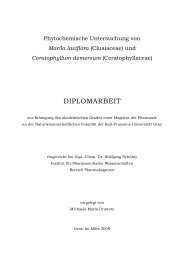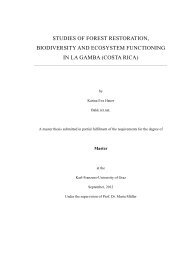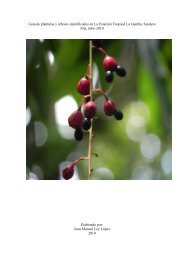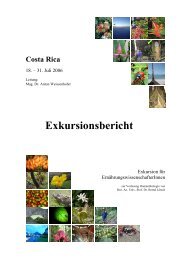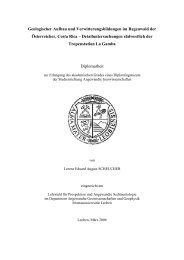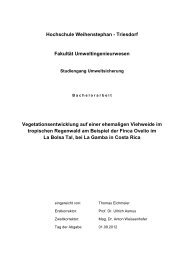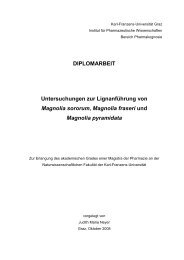Leaf colour patterns, vegetative and sexual reproduction of Episcia ...
Leaf colour patterns, vegetative and sexual reproduction of Episcia ...
Leaf colour patterns, vegetative and sexual reproduction of Episcia ...
Create successful ePaper yourself
Turn your PDF publications into a flip-book with our unique Google optimized e-Paper software.
Results: None <strong>of</strong> the covered flowers pollinated itself spontaneously <strong>and</strong> therefore<br />
development <strong>of</strong> fruits did not take place. However, the pollination <strong>of</strong> the flowers that were<br />
pollinated with their own pollen was successful i.e. self-compatibility is possible. The same is true<br />
for the experiments testing on allogamy.<br />
Discussion: The conducted experiments show that self-compatibility in <strong>Episcia</strong> lilacina is<br />
indeed possible, but is successfully prevented by two mechanisms in their natural environment.<br />
The first method is the curling <strong>of</strong> filaments so that the anthers are placed in the back area <strong>of</strong> the<br />
flowers. Due to the proximity <strong>of</strong> the anthers to the stigma during this process there is a<br />
possibility <strong>of</strong> self-pollination, which is prevented by another mechanism: The stigma stays<br />
unreceptive till the curling <strong>of</strong> the filaments has finished. In this way it is assured that the receptive<br />
stigma will not ever come in contact with the plants’ own pollen.<br />
Self-pollination is not necessary, because <strong>Episcia</strong> lilacina successfully spreads <strong>vegetative</strong>ly via<br />
stolons. Additionally, selfing is seen rarely in the family <strong>of</strong> Gesneriaceae (Weber 2004).<br />
P/O Ratio<br />
According to Cruden (1977), the pollen-ovule ratio reflects the reproductive system. By<br />
pollen-ovule ratio Cruden means the proportion <strong>of</strong> the pollen grain numbers as compared to the<br />
number <strong>of</strong> ovules in a bi<strong>sexual</strong> flower. A high P/O ratio suggests xenogamy, a lower one implies<br />
autogamy to cleistogamy. He even considered that P/O ratios better reflect the breeding system<br />
than morphological characteristics. To characterize the reproductive system <strong>of</strong> <strong>Episcia</strong> lilacina the<br />
number <strong>of</strong> the pollen grains <strong>and</strong> the number <strong>of</strong> ovule per flower were counted.<br />
Materials <strong>and</strong> Methods: Altogether, five buds were investigated. To be sure that the whole<br />
amount <strong>of</strong> pollen grains was still in the anthers, the pollen grains were counted with buds shortly<br />
before anthesis. The content <strong>of</strong> each anther was counted per h<strong>and</strong> using a stereomicroscope <strong>and</strong><br />
a grid.<br />
For the determination <strong>of</strong> the number <strong>of</strong> ovules the same buds as before were used. The<br />
gynoecium was dissected out under a stereoscope <strong>and</strong> the ovules were counted afterwards.<br />
The pollen-ovule ratio per flower was calculated by the following formula:<br />
P =<br />
O<br />
number <strong>of</strong><br />
number<br />
pollen grains per flower<br />
<strong>of</strong> ovules per flower<br />
64



